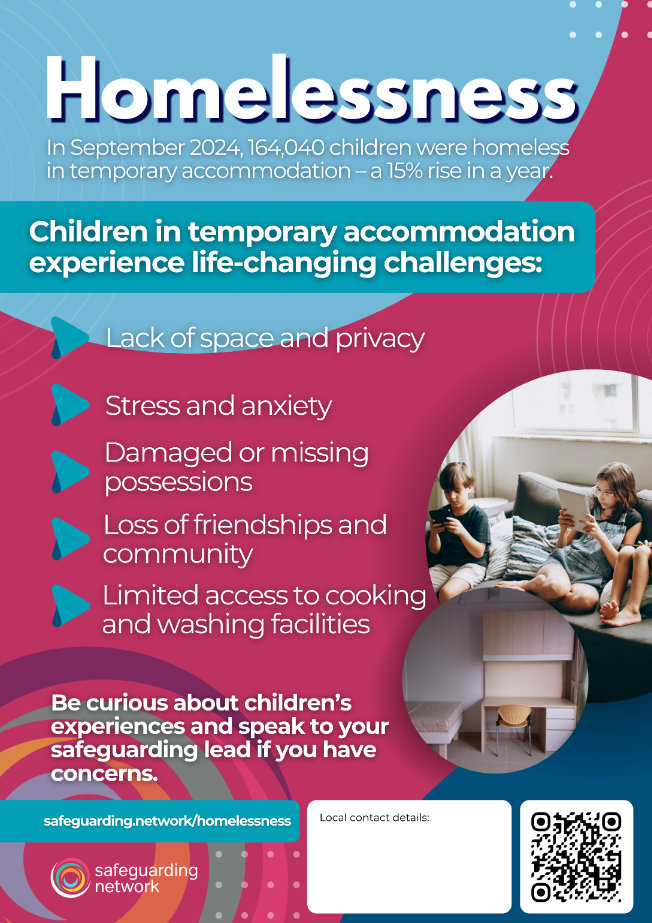Introduction
Coupled with poverty, homelessness in the UK is increasing, with life-changing effects on children. It can be difficult to understand why homelessness exists in the UK - a country which is generally considered to be wealthy nation, but there are several factors present.
Rising living costs and reductions in benefits are understood to be linked to a rise in homelessness. Lack of funds often means lack of choice, options and flexibility. Sourcing stable housing, sometimes at short notice, can be made more difficult when finances are tight.
Local authorities are not obliged to help every homeless person in their area; there are certain eligibility requirements which must be met before the local authority has a legal duty to support.
It is recognised that the cost of housing has risen and there is a lack of affordable housing, including a lack of social housing which is generally cheaper to rent. This means that even when someone is eligible for local authority support or they have an income which can pay for private rent, the options are often temporary or insecure, crowded, poorly maintained and far away from work, school, family and friends.
Need more?
Thank you for visiting our resources pages. These are free to everyone as is our fortnightly safeguarding bulletin – general safeguarding information is too important to restrict. Become a member to access lots more, including training materials for you to deliver in-house on each topic in Keeping Children Safe in Education.
Sign up for FREE fortnightly bulletin.
What about training?
We can deliver training for your setting on this and other subjects via online platforms, or face-to-face in certain areas. Just get in touch to discuss your requirements.
Definition of homelessness
The definition of homelessness means not having a home. You are homeless if you have nowhere to stay and are living on the streets, but you can be homeless even if you have a roof over your head.
You count as homeless if you are:
- staying with friends or family;
- staying in a hostel, night shelter or B&B;
- squatting (because you have no legal right to stay);
- at risk of violence or abuse in your home;
- living in poor conditions that affect your health;
- living apart from your family because you don’t have a place to live together.
Shelter (2022)
Prevalence
Homelessness goes beyond the traditional concept of people sleeping on the streets.
In England alone:
- As of September 2024, 164,040 children were homeless with their families in temporary accommodation – up 21,650 (15%) in a year.
- Between 1st April 2019 to 31st March 2024, 74 children have died with temporary accommodation as a contributing factor to their vulnerability, ill-health, or death. Of these 74 children, 58 were under the age of 1. This figure is from the All-Party Parliamentary Group for Households in Temporary Accommodation.
- More than 310,000 children (313,244) in England must share beds with other family members, due to severe overcrowding, caused by a shortage of affordable homes. This is according to a report by the National Housing Federation in April 2023.
- The same National Housing Federation report identified that more than 2 million children are living in crowded, unaffordable or unsuitable homes.
Temporary accommodation
Temporary accommodation can mean several different things. It can include families staying in bed and breakfasts (although this has been limited by the government), reception centres (large buildings with multiple bedsits and shared kitchen/dining facilities), converted office blocks or shipping containers to name a few.
All forms of temporary accommodation come with their own issues, such as:
- lack of space (indoor and/or outdoor)
- poorly maintained conditions
- issues with room heating control
- distance from “home” (i.e., where the family base is, the children go to school, etc.)
- lack of privacy
- limited cooking and washing facilities
- constantly being moved from one place to another
- others also placed in the accommodation might be single adults or people experiencing issues which are not supportive of a child and family-focussed and safe environment.
I've only got kettle and I have to go to my grandmothers for breakfast. (Girl - age 9)
There are two showers in the building. We’re meant to use the one upstairs but it doesn’t work properly, it’s hot enough to burn you. So we wake up at 5am so we can use the downstairs one, and don’t clash with the other people living here. Sometimes in the morning you’ll see stuff in the toilet and the sink. It’s disgusting. (Michael, age 14)
Homelessness and safeguarding
When families are homeless, parents can feel anger or sometimes guilt at the unfairness affecting their children. Many families do a tremendous job of minimising the impact where they can and do their best to ensure their children are well cared for and feel valued.
Homelessness in itself is not a safeguarding matter, however, it can be a factor in children being at risk of harm due to the stresses it creates in families and the limitations it places on choice. Such harms may include:
- their basic needs not being met (e.g., food, warmth, clothing) or otherwise being neglected
- social isolation, bullying
- the impact of stress within a household (including emotional abuse or domestic abuse)
- exploitation
- effects on learning and development
- caring responsibilities
- poor self-esteem and emotional health issues (in child and parent)
- a risk of substance misuse (in child and parent)
16 and 17-year-olds
Where 16 and 17-year-olds are homeless, there are significant associated vulnerabilities. There are duties on local authorities’ children’s and housing services to work together to establish whether help can be offered for the young person to return home or prevent the need for them to leave home.
Any such work should run alongside an assessment of need, and if emergency accommodation is required this should be provided whilst the assessment is taking place. If the accommodation lasts more than 24 hours, then the young person will become looked after.
There are two circumstances where a young person is not likely to be provided with accommodation by children’s services:
- If they are assessed as not being a child in need by children’s services.
- The young person is deemed to have the capacity to make informed decisions (see the Mental Capacity Act, 2005), and after being presented with all the information and potential implications of each option, decides that they do not want to be looked after by the local authority.
In these situations, the responsibility shifts to the housing authority for the area. More information about the requirements on children’s services and housing services can be found here.
Spot the signs
Being homeless can impact on many areas of a child’s life and includes indicators such as:
- tiredness – due to inappropriate sleeping areas/shared rooms/long distances to travel;
- appearance – due to lack of wash areas, no facilities to wash clothes, not being able to keep track of belongings;
- physical ill-health – due to exhaustion, lack of regular meals (shared or no cooking space), diet of ready meals/fast food, lack of space for physical activity;
- stress and anxiety – due to not knowing if or when they may have to move again;
- poor educational attainment – due to no space to do homework, no access to computers;
- poor self-esteem – due to fear of being singled out as different, not being able to join in with activities after school.
What to do
Keep talking – maintain effective communication with students, be curious about their experiences both in and out of their education setting.
Create an open and approachable culture – help students think about the issues and attitudes behind homelessness, particularly in relation to equality. Create aspiration and opportunity through high-quality teaching, while being aware of the limits and pressures on families, children and young people.
Consider how vulnerabilities might impact on individuals – think about the increased risk of exploitation and the barriers in place to attainment or to increased stability. Be aware of the effects of child poverty and homelessness.
Consider avenues of support for students and families, including local early help processes. Signpost to support services, ensuring that this is through as many different routes as possible (e.g., leaflets, posters, conversations, etc.) and how information can be accessed discretely for those who might prefer this.
The Homelessness Reduction Act (2017) placed a legal duty on English local authorities to do more to support people who are at risk of homelessness (those threatened with eviction from their home within the next 8 weeks) with the aim of preventing them becoming homeless or “relieving” their homelessness. In practice, that means working with people and their landlords to look at the reasons for the eviction, whether anything can be done to change them, and then assessing need and looking at options with those involved.
Some public bodies have a duty to refer if they identify someone who is at risk of becoming homeless. Schools have not had this duty placed on them. However, there is no reason why, with consent, you cannot refer to the local authority for support. This may also be part of an early help response.
Take action - If you have concerns that a child may be being harmed, raise your concerns with your designated safeguarding lead and follow your safeguarding procedures.
Building partnerships with parents and carers
When working with parents and carers, practitioners should prioritise a child-centred approach, fostering partnerships to ensure understanding, support and safety.
Remember:
- Collaborative efforts are crucial, especially in cases of suspected harm.
- Practitioners must engage effectively with diverse families, demonstrating empathy, respect and cultural awareness.
- Communication should be clear, inclusive and accessible. Encouraging parental/carer involvement in decision-making and valuing their input is essential.
- Involving families and communities in designing processes fosters a holistic approach to safeguarding children.
- Continuous reflection and adaptation based on feedback from parents and carers enhance practice effectiveness.
- Have you considered if:
* the setting has inclusive ways for students and families to speak about homelife, so that homelessness and or living in temporary accommodation feels less stigmatised for all?
* the signposting and information regarding income and housing support is accessible to all families, with consideration given to language, literacy, learning needs?
* the setting always offers practical assistance to families impacted by homelessness, where possible? This might be things like donated items to support hygiene and nutrition, clothing or space and time on site for students to complete their homework.
FREE homelessness poster
This downloadable resource raises the profile of safeguarding for your staff team. For use in staff rooms, on safeguarding boards or on the back of toilet doors the poster includes tips, a space for local contact details together with a link and QR Codes to this resource page. Find the poster in the resources below.
DSL Training Materials
-

Homelessness and Poverty Handout
-

Homelessness Quiz
-

Homelessness Quiz (Answers)
-

Homelessness and Poverty Presentation
-

Homelessness and Poverty Presenter Notes
-

Poverty Scenario Early Years
-

Poverty Scenario Primary and Secondary
-

Poverty Scenario Primary and Secondary - DSL Information
-

Poverty and homelessness Scenario (16+ settings)
-

Homelessness Scenario (16+ settings) - DSL Information Sheet
Resources
-

Homelessness Poster
-

What is the extent of youth homelessness in the UK?
-

The Homelessness Monitor
-

Understanding Youth Homelessness
-

Housing crisis: Children living in temporary accommodation for more than five years
-

Support and advice regarding homelessness
-

Impact of homelessness on children – research with teachers
-

‘It’s like being in prison’: Children speak out on homelessness
-

Growing up in a low-income family: Children’s experiences
Save time and improve your safeguarding approach…
Bite-size training materials to share with your staff every month.
Support to explore and develop your safeguarding culture.
A huge array of resources and professional experience at your fingertips.
Get in touch now for a personal tour of the site and details of membership benefits.
We look forward to working with you.


